Prehistory
I have long been fond of beadwork. Somehow in 2003 bought the book Donatella Chiotti "Beads", dedicated to the colors on the wire from Bead - so I learned to make flowers and trees. But this is only the technical side. But it was the inspiration that came when I had the opportunity to grow alive flowers on the site - Nature turned out to be the best teacher.This master class is devoted to gladiolus.
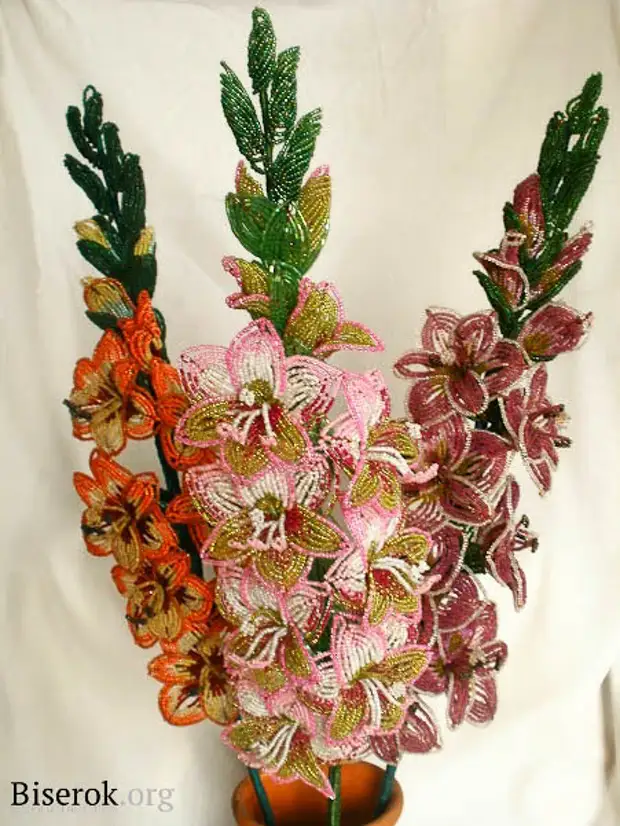
Thanks to my friend, Vladislava, who is engaged in the selection of gladiolus, I could learn more about this flower. The information was necessary in order to create a flower as much as possible. In their works, I tried to transfer it features: the height of the stem, the number of buds, flowers, their color and structure of petals (shares).
Like the previous (four) gladiolus, this was created on the basis of the photo:
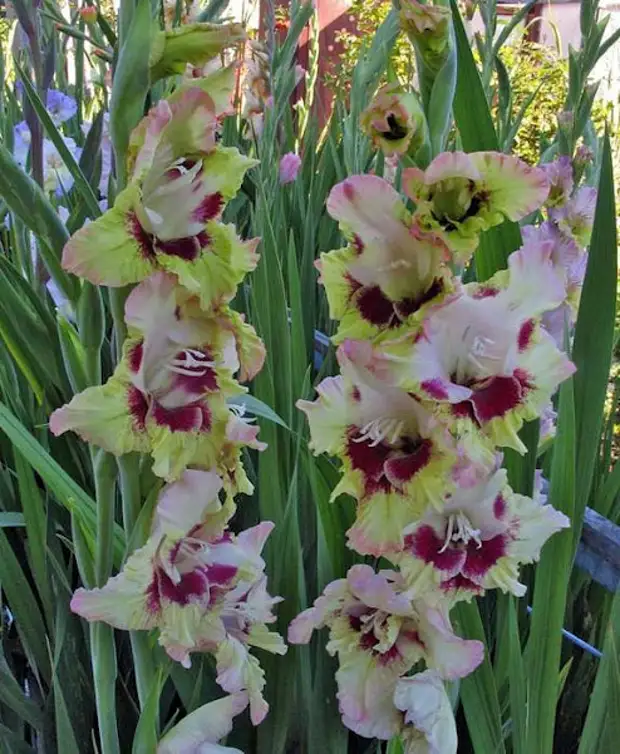
I always wanted to make gladiolus difficult painting :) On its basis, my MK was made.
For him, beads and fiberglass selected: 2 shades of green beads on buds; 2 white, 2 pink, 1 raspberry, 2 light green on flowers; Green cutting on leaves.
You do not need to do so complicated flower flower. After all, gladioluses are both absolutely monophonic and complex paints (not to mention the corrugated region, which I never decided to do: (In addition, this variety is not dwarf, there are many flowers and buds too. You can make a small gladiolus that will have a little Not 7 (like mine), but only 5 flowers (I made my very first one).
Materials:
- Beads (at least 2 colors) - green (at least 40 g) for leaves and buds, the rest (on a large can go about 100 g) for large buds and flowers;
- wire 0.3 and 0.4 (I work with two types of wire, but it is possible with one) for leaves and flowers;
- rod or pieces thick 3-4 mm thick length up to 80 cm (on large) or shorter;
- Lamps for wire, tweezers (it is convenient to be flexing the ends of the wire), pliers;
- Green threads (material does not matter), PVA glue, ruler, scissors.
Gladiolus is made in the technique of French weaving, based on the book Donatella Chiotti "Beads".
Stage 1: Leafs
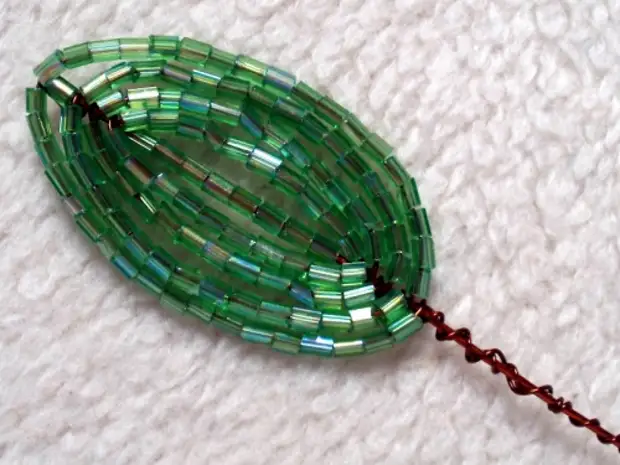
These are not the leaves that near the stem is small (like an iris) leaves, near each flower and blooming buds.
According to the idea, I had 4 large buds and 7 flowers. Everyone goes 2 such leafs - just 22 pcs.
Leafs have axes 2 cm and 4 arcs. Between the 3rd and 4th arcs on the axis add extra 2 bispers to give the leaf of acute form. Long thick wire for axis 8 cm.
Stage 2: Green Buds
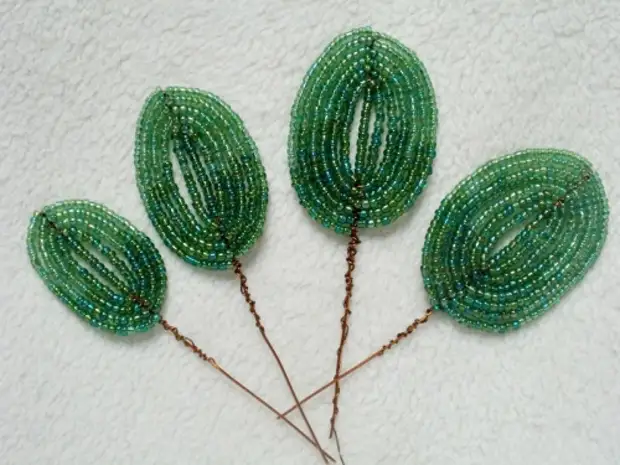
Although there are varieties that have up to 30 buds: but we will make them only four. These will be 4 green leafy of different size. I gained two shades of green beads, but you can and alone.
The axis has the same 2 cm, the number of arcs 4, 5, 6 and 7. The wire is long for the axis of 10 cm.
Stage 3: Large (Fragrance) Buds
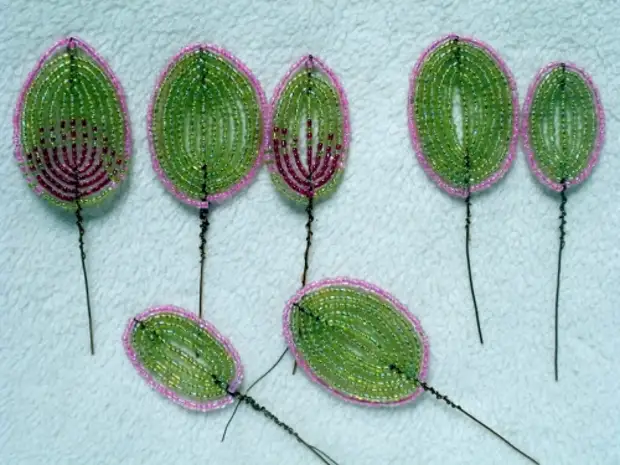
These buds have not only petals, but also 2 leafs. All of them are different sizes and the number of petals are also different. Made to ensure that our flower is like a real.
The first and second buds (they are in the photo below) have one petal, axis 2 cm, 4 and 6 arcs, respectively; The third bud consists of two petals (in the photo at the top of the right) - the same two petals as the first two buds, one less, the second is more; The fourth bud (in the photo at the top of the left) consists of one small petal and two large. Note, one big without a picture: it will be twisted, and the rest will be around it.
Stage 4: Gladiolus flowers
The flower of gladiolus consists of: 6 petals (shares), three in the upper tier and three in the lower; Pestle and three stamens. The petals are all different, but you can make four of them the same in size, and two necessarily long and narrow.
In my version there were 3 petals with an axis 2 cm 5 arcs (length of thick wire 10 cm), 2 narrow axis 2.5 cm 3 arcs, 1 small axis 1 cm 5 arcs (for narrow and small petals long thick wire wire 8 cm). All petals in front of the last arc are typed 2 bispers on the axis.
In total flowers on the flower, opened at the same time, there are 7-9 (only rare varieties are more). I did 7 pcs. You can still make flowers of different sizes: for example, 4 small and 3 large.
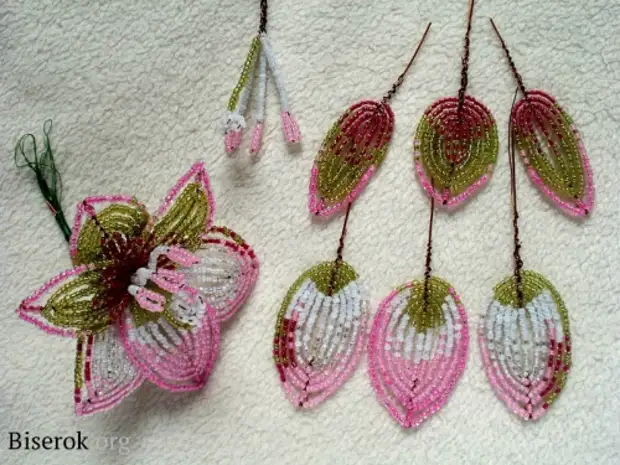
For large all axles, enlarge by 5 mm.
Pestle 3 cm high with three loops 1 cm. A piece of thin wire 20 cm. Three stamens 3 cm high with hinges 2 cm. Wire 15 cm. First, dial the loop, twist the wire with beads in the middle, perform another loops (for the pestle) , then type beads with two ends.
Stage 5: Flower Assembly
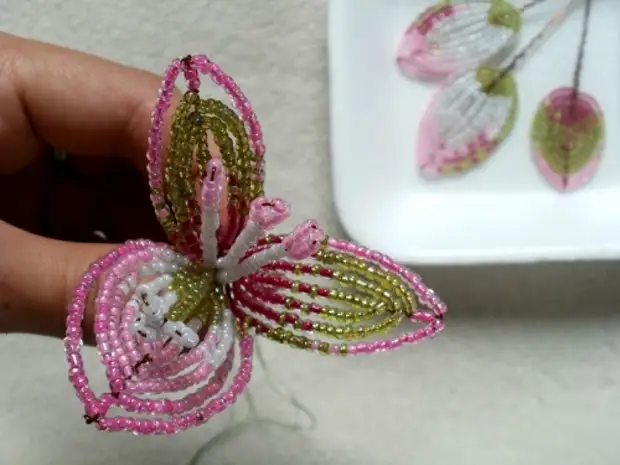
Narrow petals are always located in the upper tier. The flower is inclined, so they are either the flower at the bottom, or (which is much less frequent) at the top. Little petal is always downstairs in the second tier. Of the three large petals, one is located in the upper tier, two in the lower. All three are located at the top of the flower.
Twist together all stamens, add a pestle. Start wither threads. Take one large petal and two narrow, place them so that the narrow petals get along with the stamens, and the large petal with a pestle.
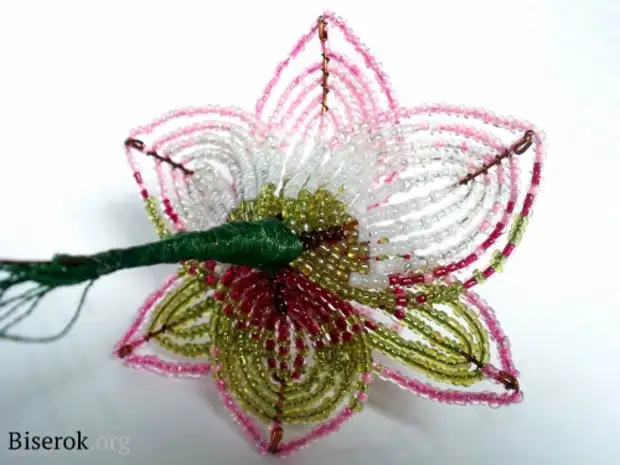
Now in the second tier, attach between a narrow little petal, then the remaining large, respectively. Everything is wrapped with 5 cm threads and loss with glue. Rear can see how the petals of the second tier are located.
Repeat the operation for all other flowers.
Stage 6: Gladiolus assembly
When all the elements are ready to assemble. Usually, flowers and buds on the stem are attached in two rows - on the right and left. Take a piece of thick wire 3-4 mm long to 80 cm or rod, wrap it 3 cm threads and punctuate. Take four green booton and twist them with a tube.
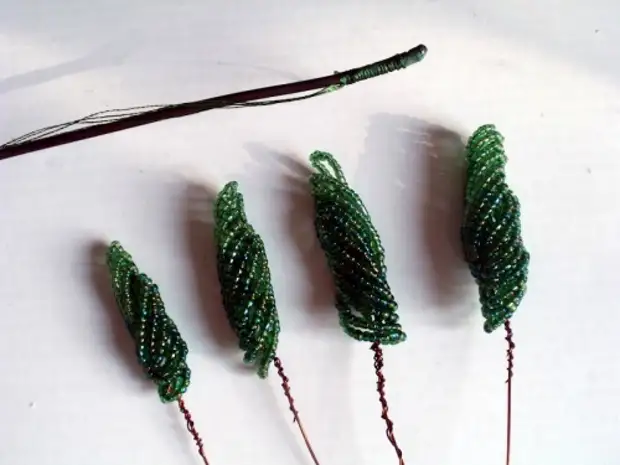
Krepim is the first, the smallest, bud - we put it on the rod, then wrap the stem for 3 cm and crepim, for example, on the right, the second bud. So retreating between the buds of 2-3 cm secrets the rest in the order of magnification, alternating the left-right side. After each element, do not forget to miss the stem glue.
Now you need to attach large buds with leaves. Between buds, the distance is also 3 cm. In addition, I added another piece of wire to the stalk (and I have three of them).
Take a small petal and twist it as well as the previous ones, secure it on the stem; Wrap a little more stem and secure two leafs so that the place of the booton fastening is closed.
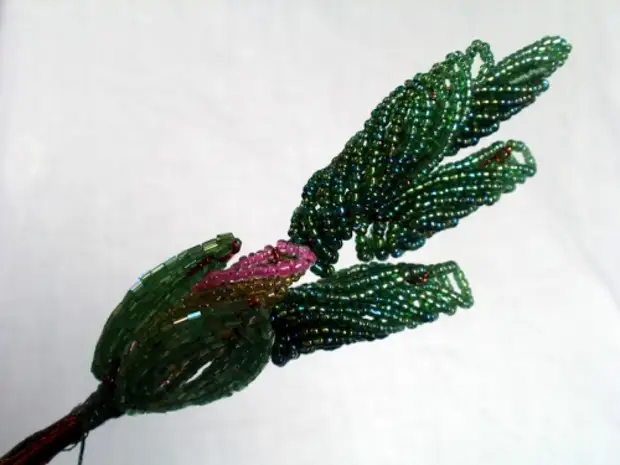
The second bud (big petal) twist and attach similarly to the first.
The third bud: a large petal twist, and small attach and beat a little to the side. Add leaves.
Fourth bud: one large petal (without a picture) twist, and the remaining attaching and bend. Add leaves.
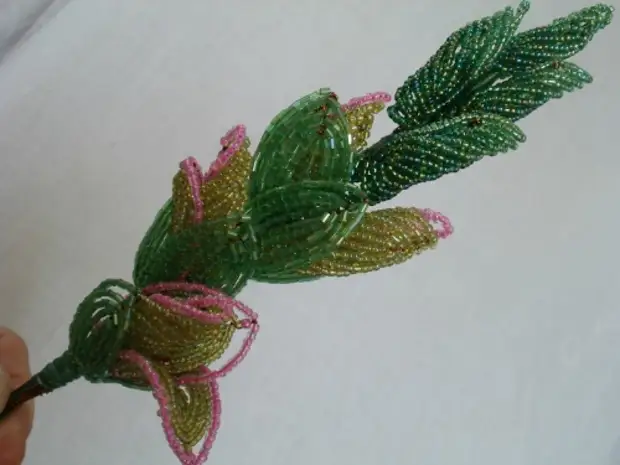
Go to the flowes. At this stage, I added a third piece of wire to the main stalk. Stem Flower Bend - from the flower to bending 3-4 cm, narrow petals and stamens at the bottom of the flower. Freak flower on the stem, wind up 3 cm and fastened leaves. We repeat for all flowers. All places are missed by glue.
After the last flower, wind the stem on the desired length and trim (as always, the grinder) are extra ends. For example, mine turned 65 cm in height.
Press the Flower shape: Injust the pestle and stamens as in the photo, remove all petals.
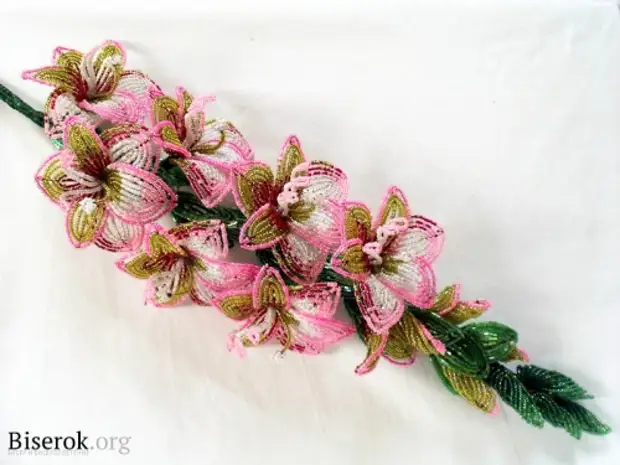
And a couple more photos:
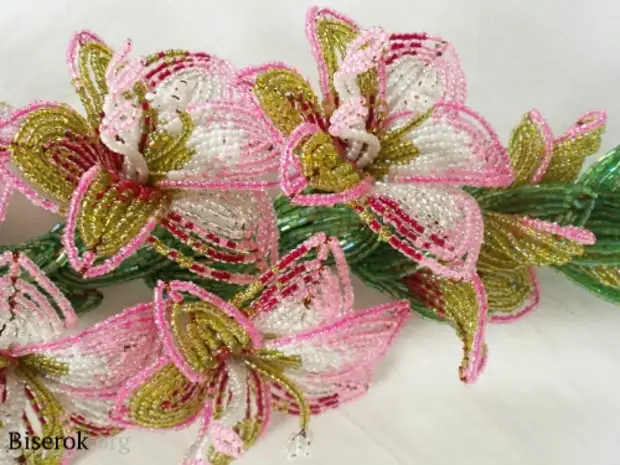
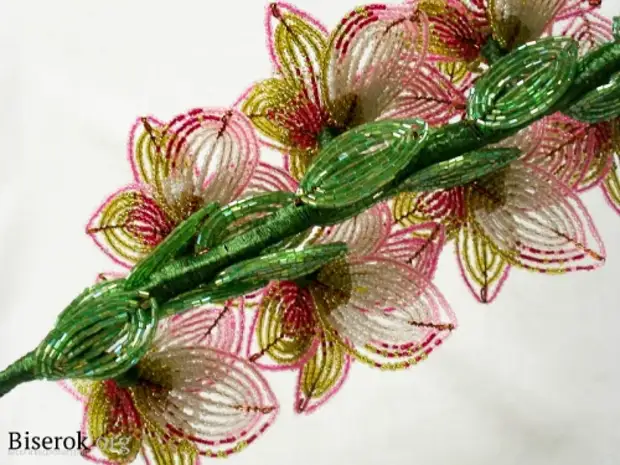
I hope you liked my MK.
Good luck!
A source
